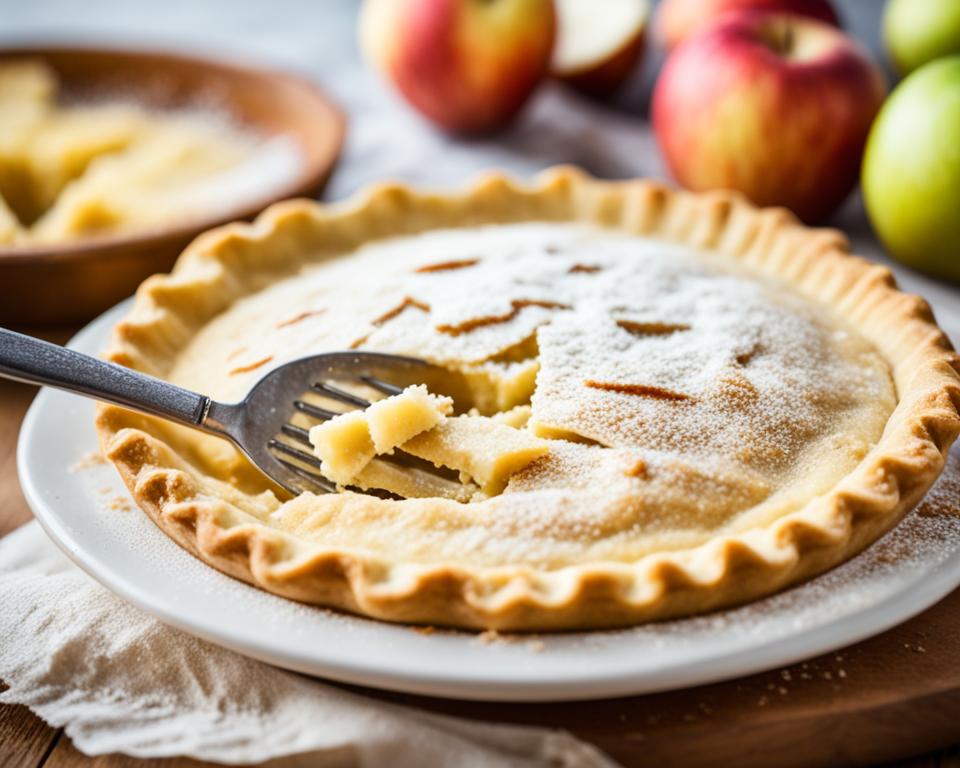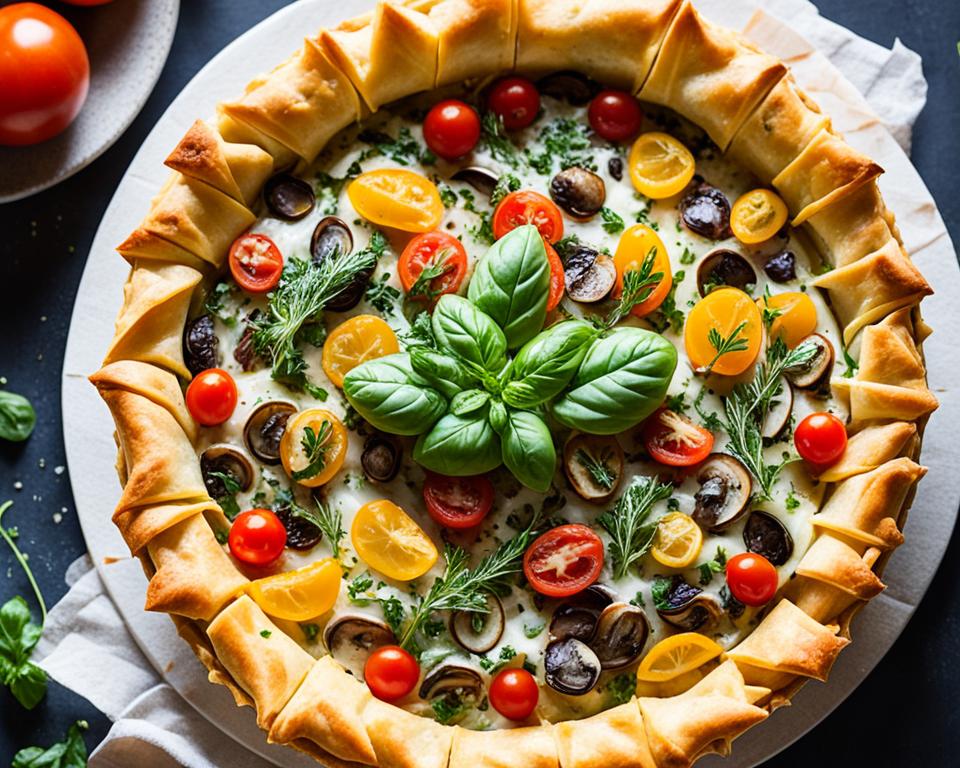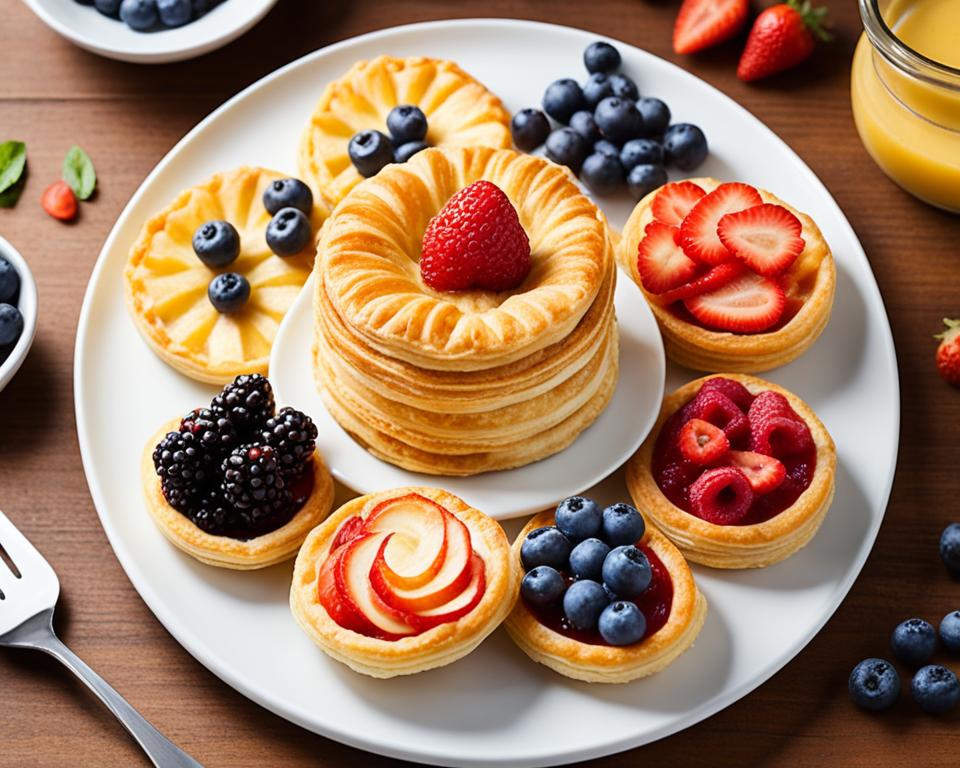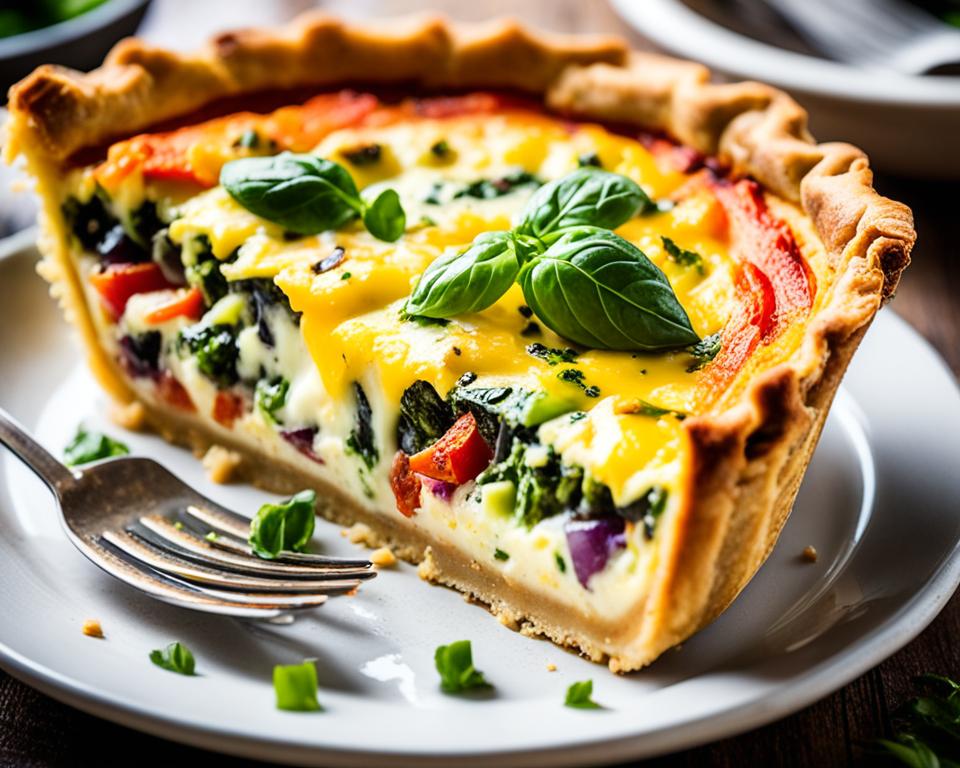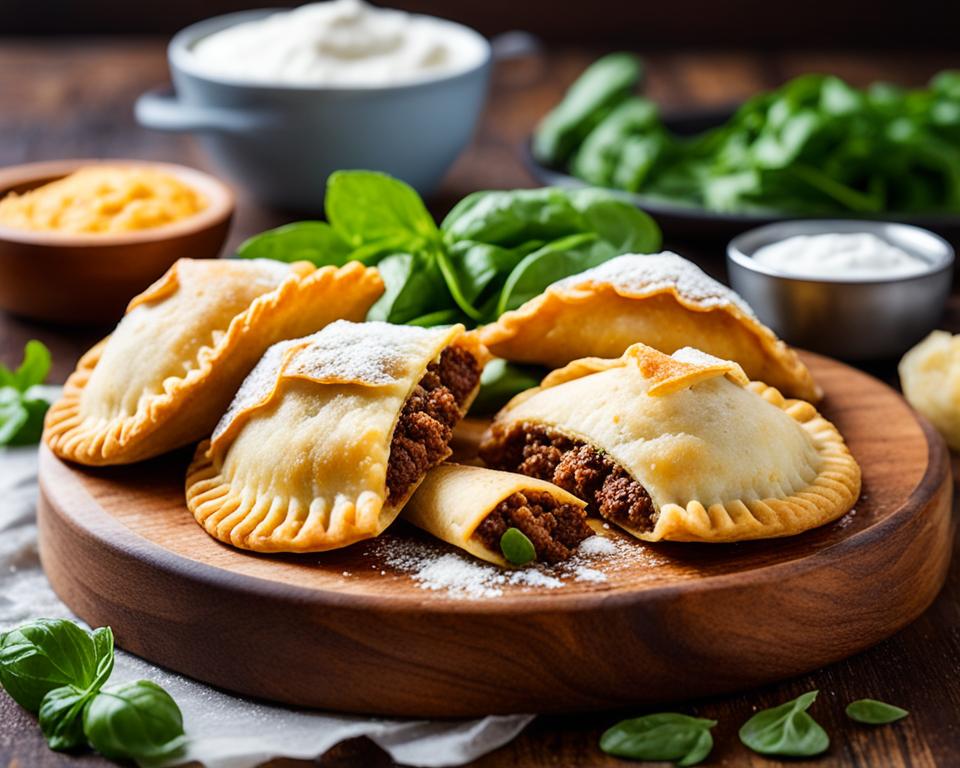Gluten-free baking can be a delight, especially when it comes to creating the perfect pie crust. Whether you’re avoiding gluten for dietary reasons or simply seeking new recipes to try, this article is here to guide you through the world of gluten-free pie crusts. Discover the best recipes that yield flaky, buttery, and delicious results every time.
From classic pie crusts to inventive variations, we’ve gathered a collection of recipes that will satisfy your cravings and impress your guests. Say goodbye to any misconceptions about gluten-free baking and embrace the possibilities of creating mouthwatering desserts with gluten-free pie crusts.
Key Takeaways:
- Explore a variety of gluten-free pie crust recipes that are flaky and easy to make.
- Learn the secrets to achieving an extra flaky gluten-free pie crust.
- Discover a tried-and-true recipe for the perfect gluten-free pie crust.
- Try an all-butter gluten-free pie crust for a flavorful twist.
- Master the tips and techniques for making the best gluten-free pie crust.
The Key to Extra Flaky Gluten-Free Pie Crust
The secret to achieving an extra flaky gluten-free pie crust lies in a few simple techniques. Keeping all your ingredients cold, using the right fats, and adding a special ingredient like sour cream or vinegar can greatly enhance the texture and flakiness of your gluten-free pie crust.
When it comes to creating a tender and flaky gluten-free pie crust, one of the key secrets is to keep all your ingredients as cold as possible. This includes cold butter or shortening, chilled water, and even refrigerating your mixing bowl and utensils. The cold temperature helps to prevent the fat from melting too quickly, resulting in a flakier crust.
Choosing the right fats is also crucial in achieving a tender and flaky gluten-free pie crust. Using solid fats like butter or shortening, rather than liquid oils, helps to create layers of flakiness. These fats coat the flour particles, resulting in a tender crust. It’s important to note that not all fats are created equal, and some may produce a better texture than others.
Adding a special ingredient like sour cream or vinegar can be the secret ingredient that takes your gluten-free pie crust to the next level. Sour cream adds richness and moisture, while vinegar helps to tenderize the dough and prevent overdevelopment of gluten. These ingredients contribute to a flakier texture and a more flavorful crust.
By following these secrets to creating a tender and flaky gluten-free pie crust, you’ll be able to enjoy a delicious homemade crust that rivals any traditional recipe. Experiment with different techniques and combinations to find the perfect crust for your favorite pies and desserts.
The Perfect Gluten-Free Pie Crust Recipe
Are you on the search for the perfect gluten-free pie crust? Look no further! This section presents a tried-and-true recipe that will consistently produce a tender and flaky crust every time. With just a few key ingredients and simple steps, you’ll be able to create an easy and delicious gluten-free pie crust that will leave everyone wanting more.
To achieve the perfect gluten-free pie crust, you’ll need the following ingredients:
- 2 cups gluten-free flour blend
- 1/2 cup unsalted butter, cold and cubed
- 1/4 cup sour cream
- 1 tablespoon white vinegar
- 1/2 teaspoon salt
- Ice water, as needed
Now, let’s dive into the step-by-step instructions for creating this amazing gluten-free pie crust:
- In a large mixing bowl, combine the gluten-free flour blend and salt.
- Using a pastry cutter or your fingertips, cut the cold butter into the flour mixture until it resembles coarse crumbs.
- Add the sour cream and vinegar to the mixture, and mix until a dough starts to form.
- If the dough feels too dry, gradually add ice water, a tablespoon at a time, until the dough comes together without being sticky.
- Shape the dough into a ball, then flatten it into a disc and wrap it in plastic wrap. Refrigerate for at least 30 minutes.
- After chilling, place the dough on a lightly floured surface and roll it out to fit your pie dish.
- Gently transfer the rolled-out crust to your pie dish, pressing it into the bottom and sides.
- Trim any excess dough and crimp the edges for a decorative finish.
- At this point, you can either fill the pie crust with your desired filling, or pre-bake the crust according to your recipe’s instructions.
And voila! You now have a perfect gluten-free pie crust ready to be filled with your favorite flavors. Whether you’re making a classic apple pie, a tangy lemon meringue pie, or a rich chocolate cream pie, this crust will beautifully complement your chosen filling.
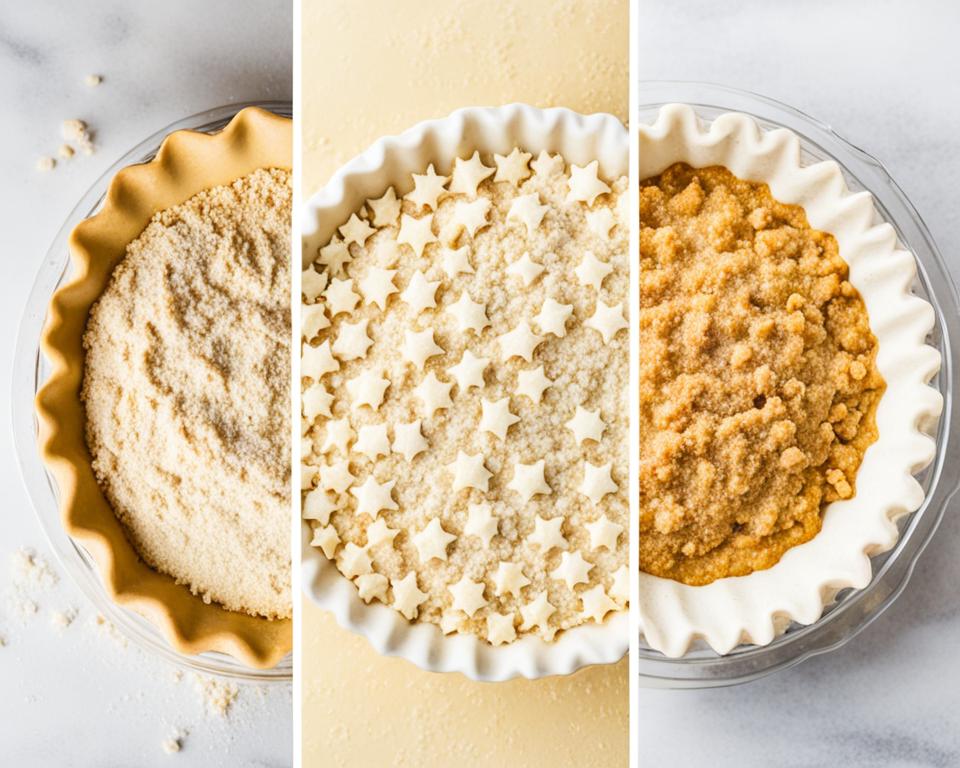
Don’t let dietary restrictions keep you from enjoying delicious homemade pies. With this easy gluten-free pie crust recipe, you can indulge in all your favorite desserts with confidence. So grab your rolling pin and get ready to impress your friends and family with a flaky, flavorful pie crust that rivals any traditional version!
All Butter Gluten-Free Pie Crust Recipe
If you’re searching for a gluten-free pie crust recipe that is both flaky and flavorful, look no further. This all butter gluten-free pie crust is a game-changer in the world of gluten-free baking. With a few simple ingredients and some handy tips, you can easily create a crust that rivals its wheat-based counterparts.
The secret to achieving a flaky texture lies in the combination of a gluten-free flour blend, cold butter, and a touch of ice water. This recipe ensures that the butter is evenly distributed throughout the dough, resulting in layers of buttery goodness once baked. The end result is a crust that will make you forget it’s gluten-free.
Ingredients:
- 1 1/2 cups gluten-free flour blend
- 1/2 teaspoon salt
- 1/2 cup cold unsalted butter, cut into small cubes
- 4-6 tablespoons ice water
Instructions:
- In a large bowl, whisk together the gluten-free flour blend and salt.
- Add the cold butter cubes to the flour mixture. Using a pastry cutter or your fingertips, cut the butter into the flour until the mixture resembles coarse crumbs.
- Add the ice water, one tablespoon at a time, and mix until the dough comes together. Be careful not to overmix.
- Shape the dough into a ball and flatten into a disk. Wrap it in plastic wrap and refrigerate for at least 1 hour.
- When ready to use, remove the dough from the refrigerator and let it sit at room temperature for a few minutes to make it easier to roll out.
- Place the dough between two sheets of parchment paper and roll it out to fit your pie dish.
- Remove the top layer of parchment paper and carefully transfer the crust to your pie dish. Press the crust gently into the dish, making sure it is evenly distributed.
- Trim any excess dough around the edges and crimp as desired.
- Proceed with your favorite pie recipe, or blind bake the crust according to the instructions for a pre-baked pie shell.
With this all butter gluten-free pie crust recipe, you can enjoy the flakiness and buttery flavor of a traditional pie crust without the gluten. Whether you’re making a sweet apple pie or a savory quiche, this crust will deliver exceptional results. The best part? It’s so easy to make that even beginner bakers can achieve delicious gluten-free pies. So go ahead and indulge in your favorite pie recipes with this buttery, gluten-free twist!
How to Make the Best Gluten-Free Pie Crust
Making the best gluten-free pie crust involves a few key tips and techniques. By following these expert secrets, you can create a delicious and flaky crust that rivals any traditional recipe. Whether you’re new to gluten-free baking or looking to improve your skills, these tips will guide you towards perfection.
Choose the Right Gluten-Free Flour Blend
The choice of flour blend is crucial for a successful gluten-free pie crust. Look for a blend specifically designed for baking, such as Bob’s Red Mill 1-to-1 Gluten-Free Baking Flour. This blend already contains xanthan gum, which improves the texture and structure of the crust.
Keep Ingredients Cold
When making gluten-free pie crust, it’s essential to keep all your ingredients as cold as possible. This helps prevent the fats from melting and ensures a flaky texture. Chill the flour blend, butter, and any other ingredients in the refrigerator for at least 30 minutes before use.
Use the Right Fats
Choosing the right fats is key to a delicious gluten-free pie crust. Opt for a combination of solid fats like butter and shortening, as this will create a tender and flaky texture. The butter adds flavor, while the shortening provides structure. For a dairy-free option, try using vegan butter or coconut oil instead.
Don’t Overwork the Dough
When combining the ingredients to form the dough, be mindful not to overmix or overwork it. Overworking the dough can lead to a tough crust. Mix just until the ingredients are incorporated, and the dough holds together when pressed between your fingers.
| Tips for Making the Best Gluten-Free Pie Crust |
|---|
| Choose a high-quality gluten-free flour blend. Keep all ingredients cold throughout the process. Use a combination of solid fats like butter and shortening. Don’t overwork the dough. Add a teaspoon of vinegar or lemon juice to enhance the flakiness. Add a touch of xanthan gum if your flour blend doesn’t contain it. Roll the dough between two sheets of parchment paper for easy handling. Chilling the shaped dough in the refrigerator for at least 30 minutes before baking. Blind bake the crust before adding the filling for a crisp texture. |
By following these tips, you can unlock the secrets to perfect gluten-free pie crust. Experiment with different flavors, fillings, and variations to create your own signature pies. Your friends and family will be amazed by the delicious and professional-quality gluten-free crust you’ve created.
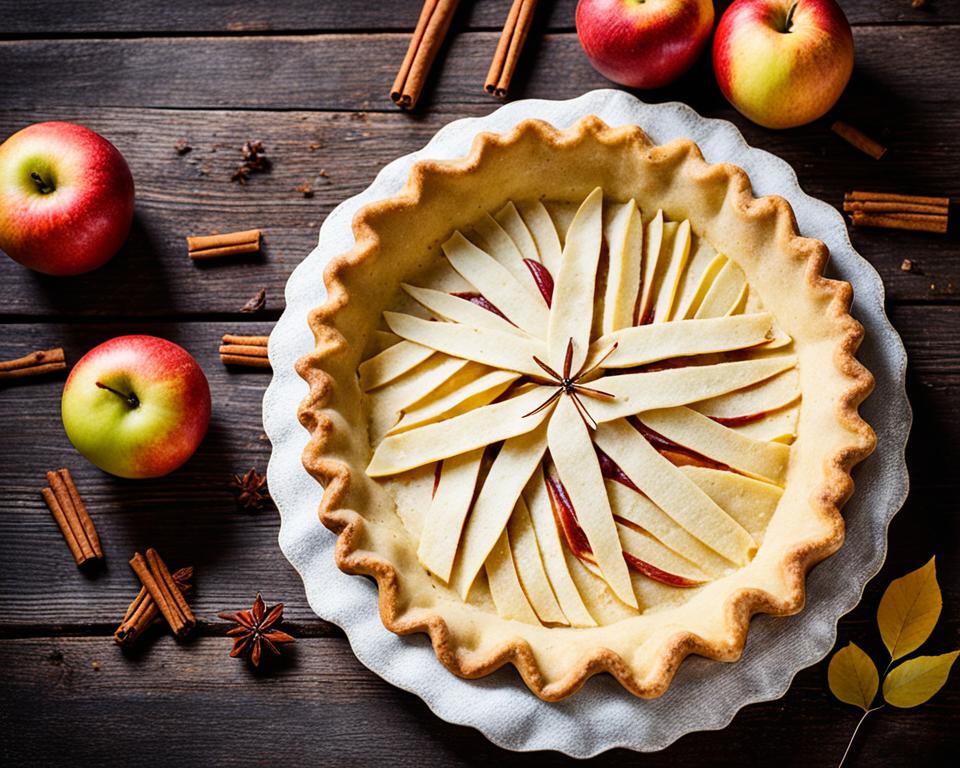
“The smell of a freshly baked gluten-free pie crust is simply irresistible. With the right techniques, you can create a mouthwatering crust that satisfies all dietary needs while maintaining incredible flavor and texture.”
Troubleshooting Common Issues with Gluten-Free Pie Crust
Gluten-free pie crusts can pose challenges, but don’t let that discourage you. With the right troubleshooting techniques, you can easily overcome common issues and achieve the perfect gluten-free pie crust every time. This section addresses some of the common problems you may encounter, such as toughness, shrinkage, and sogginess, and provides effective solutions to fix these problems.
Toughness
If your gluten-free pie crust turns out tough, it can be quite disappointing. Fortunately, there are a few things you can do to improve the texture:
- Choose the right flour blend: Different gluten-free flour blends have varying textures. Opt for a blend specifically designed for pie crusts, which will have a lighter and more delicate texture.
- Don’t overwork the dough: When mixing the ingredients, avoid overmixing as it can activate the gluten-free flours’ proteins and result in a tougher crust. Mix the ingredients just until they come together.
- Add a little fat: Incorporating a small amount of additional fat, such as a couple of tablespoons of vegetable shortening or cream cheese, can help improve the tenderness of the crust.
Shrinkage
Dealing with a shrunken gluten-free pie crust can be frustrating, but these tips can help you prevent or minimize shrinkage:
- Chill the dough: After preparing the dough, make sure to refrigerate it for at least 30 minutes before rolling it out. This helps relax the gluten-free flours and reduces the chances of shrinkage.
- Roll out the dough evenly: Roll the dough into a circle larger than your pie pan, ensuring it has a consistent thickness throughout. Trim any excess dough, leaving a slight overhang, before crimping the edges.
- Blind bake the crust: To further prevent shrinkage, consider blind baking the crust. Place parchment paper or aluminum foil on top of the crust and fill it with pie weights or dried beans before baking. This helps maintain the shape during the initial baking process.
Sogginess
Nothing ruins a pie faster than a soggy crust. To avoid a soggy gluten-free pie crust, try these tips:
- Prevent over-moistening: When adding any liquids to your pie crust, ensure you only use the amount specified in the recipe. Excess moisture can lead to sogginess.
- Bake at a higher temperature: Baking the pie at a slightly higher temperature, such as 425°F (220°C), creates steam faster, which reduces the chances of a soggy crust.
- Consider a pre-bake: For fillings that have a high moisture content, such as custard or fruit pies, you can partially pre-bake the crust before adding the filling. This forms a barrier between the filling and the crust, preventing sogginess.
By applying these troubleshooting techniques, you can address and overcome the common issues that may arise when making a gluten-free pie crust. With a little practice and experimentation, you’ll soon be able to enjoy a perfectly flaky and delicious gluten-free pie crust every time.
Creative Ideas for Gluten-Free Pie Crust
Gluten-free pie crust is not limited to just traditional pies. There are plenty of creative and unique ways to use this versatile crust. Whether you want to impress your guests or simply try something new, these ideas will inspire you to think outside the pie tin!
Here are some creative pie crust recipes and unique uses for gluten-free pie crust:
1. Tartlets and Galettes
Create bite-sized treats by using gluten-free pie crust to make tartlets and galettes. These individual-sized pastries can be filled with sweet or savory fillings, such as fruit compote, creamy cheese, or roasted vegetables. The flaky crust adds a delightful texture to these miniature delights.
2. Savory Pies and Quiches
Experiment with bold flavors by using gluten-free pie crust to make savory pies and quiches. Fill the crust with a delicious combination of vegetables, meats, and cheeses for a hearty meal. Whether it’s a comforting chicken pot pie or a flavorful spinach and feta quiche, the gluten-free crust will hold it all together perfectly.
3. Pizza and Flatbreads
Take pizza night to the next level by using gluten-free pie crust as a base for your pizza or flatbread. Roll out the crust, add your favorite toppings, and bake it to perfection. Whether you prefer classic flavors like margherita or more adventurous combinations, the gluten-free crust will provide a delicious foundation for your pizza creations.
4. Dessert Cups and Cheesecake Bases
Create elegant and individually portioned desserts by using gluten-free pie crust to make dessert cups or cheesecake bases. Press the crust into mini tart pans or muffin tins, and fill them with creamy fillings like chocolate mousse, fruit curd, or cheesecake batter. The crust will add a flavorful and sturdy base to these delectable treats.
5. Crumbly Toppings and Crust Cookies
If you have some leftover gluten-free pie crust, don’t let it go to waste. Transform it into crumbly toppings for fruit crisps or cobblers by crumbling it over the filling before baking. You can also turn the crust into delicious crust cookies by cutting it into shapes, sprinkling with sugar and cinnamon, and baking until golden brown.
“Get creative with your gluten-free pie crust and explore a world of delicious possibilities!”
With these unique ideas, you can make the most of your gluten-free pie crust and create extraordinary dishes that will impress both gluten-free and non-gluten-free diners. Enjoy the versatility and taste of gluten-free pie crust in these creative recipes!
But why stop here? In the next section, we’ll explore various gluten-free pie crust variations to suit different dietary needs. From dairy-free options to vegan alternatives, you’ll discover how to adapt the pie crust to accommodate your specific requirements.
Variations for Dietary Needs
This section offers variations of gluten-free pie crust to accommodate different dietary needs. Whether you need a dairy-free or vegan option, there are substitutions and tips to help you create a delicious gluten-free pie crust that suits your specific dietary restrictions. Explore the possibilities and enjoy a tasty pie crust that fits your lifestyle.
Dairy-Free Gluten-Free Pie Crust
For those who are lactose intolerant or follow a dairy-free diet, there are several alternatives to butter that can be used in gluten-free pie crust recipes. Here are a few options:
- Coconut Oil: Substitute an equal amount of solid coconut oil for the butter in the recipe. Make sure the coconut oil is cold and firm, so it can be cut into the flour mixture.
- Vegan Margarine: Look for a dairy-free, vegan margarine that is suitable for baking. Use it as a replacement for butter in the pie crust recipe.
- Shortening: Use dairy-free shortening instead of butter. Keep in mind that shortening may alter the flavor and texture of the crust.
Experiment with these dairy-free alternatives to create a flaky and delicious gluten-free pie crust that everyone can enjoy.
Vegan Gluten-Free Pie Crust
For those following a vegan lifestyle, there are additional modifications that can be made to ensure your gluten-free pie crust is both dairy-free and free of any animal products. Here are some vegan-friendly options:
- Plant-Based Butter: Look for a vegan butter or margarine that is labeled as plant-based or dairy-free. Use it as a substitute for regular butter.
- Applesauce: Replace the butter with unsweetened applesauce. This will add moisture to the dough and help bind the ingredients together.
- Nut Butter: Use a smooth nut butter, such as almond or cashew butter, as a vegan replacement for butter. Keep in mind that nut butters may alter the flavor of the crust.
- Vegetable Oil: Substitute an equal amount of vegetable oil for the butter. This will result in a slightly different texture, but it can still create a tasty and vegan-friendly pie crust.
By using these vegan alternatives, you can enjoy a delicious gluten-free pie crust that aligns with your dietary choices.
Remember to check ingredient labels carefully to ensure that all the products you use are truly gluten-free and suitable for your specific dietary needs.
table {
width: 100%;
border-collapse: collapse;
}
th, td {
padding: 8px;
text-align: left;
border-bottom: 1px solid #ddd;
}
th {
font-weight: bold;
}
| Dietary Needs | Substitutions |
|---|---|
| Dairy-Free | Coconut Oil, Vegan Margarine, Shortening |
| Vegan | Plant-Based Butter, Applesauce, Nut Butter, Vegetable Oil |
Make-Ahead and Storage Tips
Planning ahead is key when it comes to baking with gluten-free pie crust. With these make-ahead and storage tips, you can prepare your pie crust in advance and have it ready to use whenever needed. Whether you want to save time or make multiple crusts for future use, these strategies will ensure your gluten-free pie crust is convenient and fresh.
Make-Ahead Tips
If you’re planning to make gluten-free pie crust for an upcoming event or simply want to get ahead in your baking, these make-ahead tips will be your lifesaver. By preparing your pie crust dough in advance, you’ll be able to save time and streamline your baking process. Here’s how:
- Prepare the pie crust dough as per your chosen recipe.
- Shape the dough into a disc and wrap it tightly in plastic wrap.
- Optional: If your recipe requires chilling the dough before rolling it out, you can do that at this stage.
- Label the wrapped dough with the date and store it in the refrigerator.
Note: Depending on the recipe, some pie crusts can be refrigerated for up to 3 days before use. Always refer to your chosen recipe for specific guidelines.
Storage Tips
Whether you have leftover unbaked pie crust or want to make extra batches for future use, proper storage is essential to maintain the integrity and freshness of your gluten-free pie crust. Follow these storage tips to ensure your crust remains delicious:
- Refrigerator Storage: If you have leftover unbaked pie crust dough, wrap it tightly in plastic wrap and place it in an airtight container or resealable bag. Store it in the refrigerator for up to 3 days.
- Freezing Baked Pie Crust: If you have already baked your pie crust and want to freeze it for later use, allow it to cool completely. Once cooled, wrap it tightly in plastic wrap and place it in an airtight container or resealable bag. Freeze it for up to 2-3 months.
- Freezing Unbaked Pie Crust: For unbaked pie crusts, you can freeze them in two ways:
| Method | Instructions |
|---|---|
| Freezing Rolled-Out Crust: |
|
| Freezing Discs of Dough: |
|
Note: When you’re ready to use the frozen pie crust, allow it to thaw in the refrigerator overnight before rolling out and baking as usual.
Best Fillings for Gluten-Free Pie Crust
A delicious crust deserves a delectable filling. When it comes to gluten-free pie crust, there are numerous options that will satisfy your taste buds. Check out these mouthwatering fillings that perfectly complement a flaky gluten-free pie crust:
1. Gluten-Free Apple Pie Filling
Indulge in the classic combination of sweet apples, warm spices, and a buttery crust with a gluten-free apple pie filling. Whether you prefer tart Granny Smith apples or the sweetness of Honeycrisp, this filling will create a pie that’s bursting with flavor. Sprinkle some cinnamon and nutmeg for an extra touch of warmth and serve it warm with a scoop of vanilla ice cream.
2. Gluten-Free Pecan Pie Filling
A rich and gooey pecan pie filling can take your gluten-free pie crust to the next level. Pecans add a satisfying crunch and a nutty sweetness that pairs perfectly with the buttery crust. Drizzle some maple syrup on top for an irresistible finish. This classic Southern dessert is sure to impress your family and friends.
3. Gluten-Free Chocolate Chip Pie Filling
If you’re a fan of chocolate, then a gluten-free chocolate chip pie filling is a must-try. This decadent filling combines silky chocolate, gooey chocolate chips, and a touch of vanilla for a dessert that will satisfy any chocolate lover. Serve it warm with a dollop of whipped cream for a truly indulgent experience.
4. Gluten-Free Coconut Cream Pie Filling
For a tropical twist, try a gluten-free coconut cream pie filling. This creamy and dreamy filling is made with coconut milk, toasted coconut flakes, and a hint of vanilla. It pairs beautifully with a flaky gluten-free crust, creating a pie that’s refreshing and light. Top it off with whipped cream and toasted coconut for an extra touch of elegance.
Experiment with these fillings and let your creativity soar. The possibilities are endless when you combine a flaky gluten-free pie crust with delicious fillings. Whether you’re baking for a special occasion or a cozy night in, these fillings will satisfy your dessert cravings.
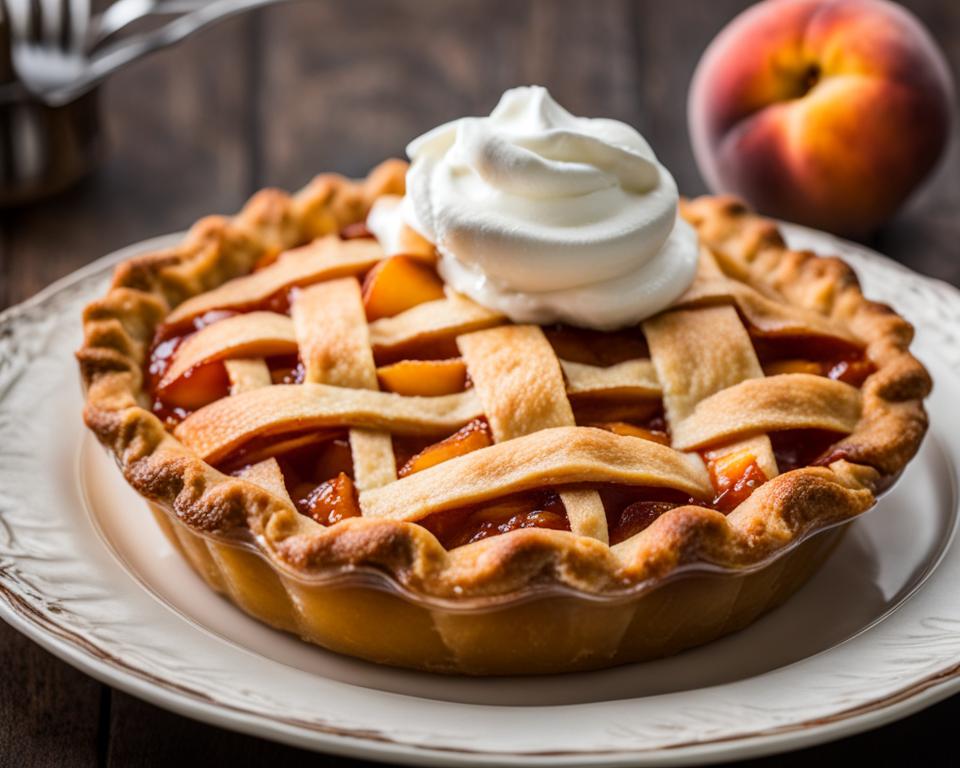
Conclusion
In conclusion, this article has provided a comprehensive summary of gluten-free pie crust recipes. From classic to innovative variations, these recipes offer a delicious and flaky alternative for those following a gluten-free diet. By following the tips and techniques mentioned, you can achieve the perfect texture and taste in your gluten-free pie crusts.
Additionally, this article has addressed common issues that may arise when making gluten-free pie crusts, offering troubleshooting advice to help you overcome any challenges. Moreover, the creative ideas section has showcased unique uses for gluten-free pie crusts, inspiring you to think beyond traditional pies and explore new flavors and textures.
Lastly, the make-ahead and storage tips provided in this article ensure that you can conveniently prepare and store gluten-free pie crusts, saving time and effort when planning your baking endeavors. With these valuable insights and resources, you can confidently embark on your gluten-free baking journey and enjoy the delectable results.
FAQ
What are some tips for achieving an extra flaky gluten-free pie crust?
Keeping all your ingredients cold, using the right fats, and adding a special ingredient like sour cream or vinegar can greatly enhance the texture and flakiness of your gluten-free pie crust.
What is the recipe for the perfect gluten-free pie crust?
The perfect gluten-free pie crust recipe includes a combination of gluten-free flour blend, butter, sour cream, and a touch of vinegar. It produces a tender and flaky crust every time.
Is there an all-butter gluten-free pie crust recipe available?
Yes, there is an all-butter gluten-free pie crust recipe. It uses a combination of gluten-free flour blend, cold butter, and a touch of ice water to create a flaky and flavorful crust.
What are some tips for making the best gluten-free pie crust?
Some tips for making the best gluten-free pie crust include choosing the right gluten-free flour blend and properly chilling the dough. These steps will help you achieve a flaky and delicious crust.
How can I troubleshoot common issues with gluten-free pie crust?
To troubleshoot common issues with gluten-free pie crust, such as toughness, shrinkage, and sogginess, you can follow specific techniques and tips to fix these problems and achieve the perfect crust.
Can gluten-free pie crust be used for purposes other than traditional pies?
Yes, gluten-free pie crust can be used in various creative ways, such as making tartlets, galettes, savory pies, and mini quiches. There are endless possibilities for incorporating gluten-free pie crust into unique and delicious recipes.
Are there variations of gluten-free pie crust available for different dietary needs?
Yes, there are variations of gluten-free pie crust available to accommodate different dietary needs, including dairy-free and vegan options. Substitutions and tips are provided to help create delicious gluten-free pie crusts that suit specific dietary restrictions.
What are some make-ahead and storage tips for gluten-free pie crust?
To make-ahead and store gluten-free pie crust, it is important to properly chill the dough and follow specific techniques. This section provides useful tips for preparing and storing gluten-free pie crusts for maximum convenience and freshness.
What are some recommended fillings to pair with gluten-free pie crust?
Some recommended fillings to pair with gluten-free pie crust include apple pie, pecan pie, chocolate chip pie, and coconut cream pie. These fillings are made using gluten-free ingredients, creating a delicious combination with the flaky crust.
What is the final summary of the best gluten-free pie crust recipes?
The article has revealed the best gluten-free pie crust recipes, provided tips and techniques, offered troubleshooting advice, explored creative possibilities, and shared storage tips. With these recipes and guidance, you can enjoy the buttery, flaky goodness of gluten-free pie crust in all your favorite desserts.

